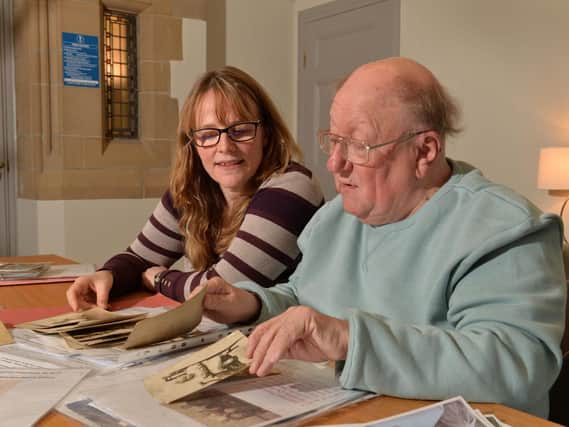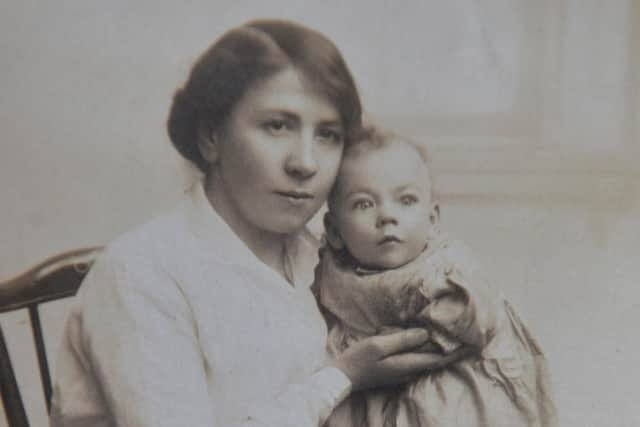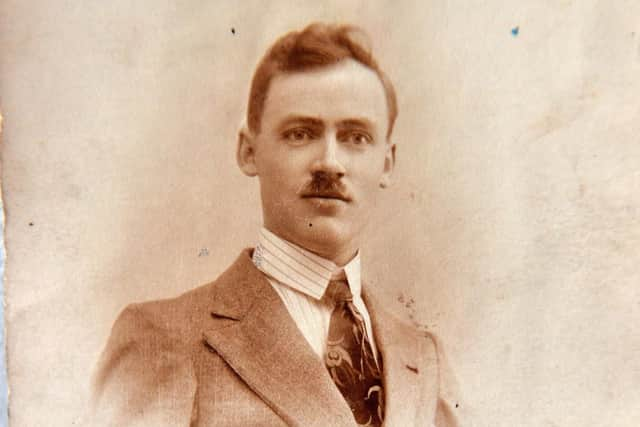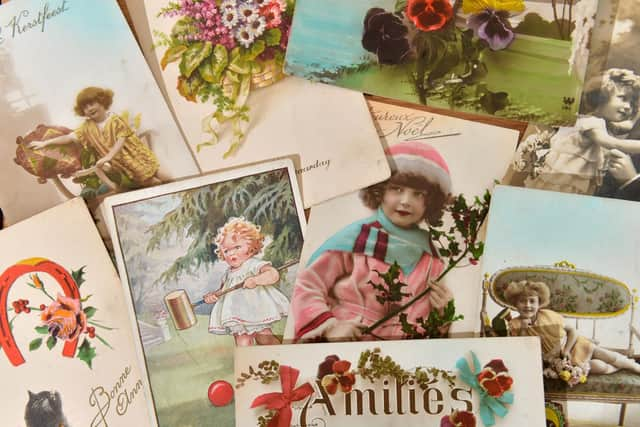How First World War romance led Leeds man to discover Belgian relatives 100 years on


The postcards that Michael Hassell discovered in a trunk of his late mother’s have taken him on an overwhelming journey to meet Belgian relatives he did not even know he had.
Sent by a grandfather he never met, the collection of cards date back to the years immediately following the First World War and paint a picture of how a historic love story panned out in a time when conflict forced thousands of men, women and children to relocate, sparking new friendships and relationships among people whose paths would not normally have crossed.
Advertisement
Hide AdAdvertisement
Hide Ad

Cyrille Desaeger was one of those. A Belgian soldier, Cyrille spent time in Britain recuperating from wounds in convalescent hospitals during the Great War. It was a period that led him to meet Elizabeth Wark - Michael’s grandmother, though exactly when and where remains unascertained.
In 1918, Lizzie, as she was known, fell pregnant with Cyrille’s child. Unmarried, and fearful of telling her father, she was sent by her mother and sister to the family’s native Northern Ireland where she gave birth to Margaret, Michael’s mum, in Londonderry the following year, before returning to England several months later.
“Cyrille never got to see Margaret because he’d gone by the time they came back, so he never saw his daughter,” Michael, who lives in Headingley, explains.
He did keep in touch though, writing loving postcards to Margaret and Lizzie, whom it is believed he wanted to marry, until 1924. There was even talk of an engagement ring.
Advertisement
Hide AdAdvertisement
Hide Ad

“When you read the cards, it seems he thought the relationship was ongoing. He was expecting them to go Belgium. The cards were saying ‘won’t it be great when you’re over here with me’ and ‘when are you coming?’ and ‘when you’re here next Christmas we will do this’, but Lizzie never went.
“Now I don’t know if she was as committed to the relationship as he was or whether she was just being practical, because in 1924 he was still in a [convalescent] home so he had no home, he had no job and he had only a meagre war pension to support them on.”
Michael grew up knowing little about his maternal granddad; he was aware his mother was illegitimate and that his grandfather was a Belgian soldier, who he was told had spent time recuperating from war wounds at Leeds’s Temple Newsam stately home, used as a convalescent hospital during the war.


He discovered the postcards amongst his mother’s belongings following her death in 2008.
Advertisement
Hide AdAdvertisement
Hide Ad“I think I might have seen them before, but I don't remember there being a big thing made of them and I certainly hadn't seen them for 20 or 30 years."
In 2014, with the centenary of the start of the war, Michael began to think more about their significance.
He showed them to his neighbour, a historian, who passed them onto Professor Alison Fell at University of Leeds, who was advising on an exhibition on Temple Newsam and its history as a convalescent home, as part of a university centenary project entitled the Legacies of War.
The postcards, and what Michael knew of Cyrille’s story at the time, became a central part of the display in 2015 (and a video - above - was also produced by Deadline Digital) though no more about his life was uncovered until January this year; during a trip to Belgium, Alison looked at Cyrille’s military file, revealing, amongst other details, that his hometown was Sint-Gillis-bij-Dendermonde in East Flanders.
Advertisement
Hide AdAdvertisement
Hide AdShe wrote to the area’s town hall to ask for information about Cyrille and his family and passed on a letter from Michael to give to relatives in Belgium that could be traced. In May, he received an email from a granddaughter of Cyrille. In the end, six of his grandchildren made contact.
Michael learnt that his grandfather, who died in 1982, returned to his hometown, married in 1927 and went on to have three further children.His wedding date was a day after Margaret’s birthday “so every time his wedding anniversary came around he would have been reminded of his daughter”.
Of Margaret and Lizzie, the grandchildren had no idea, though one relative said some members of the family were certainly aware.
“She remembers the story coming out when his wife found out that he had another woman and a child in the UK and, to put it politely, the balloon went up...there was a big uproar and it was decided it would never be mentioned again.”
Advertisement
Hide AdAdvertisement
Hide AdMichael visited Belgium to meet the long-lost relatives in July, a trip that was filmed by the BBC, who had been contacted about his story by the university, for a section due to feature on the Inside Out programme at 7.30pm tonight.
“It was all very easy,” says Michael, who was greeted with a welcome sign.
Born in September 1893, the son of a peasant farmer, Cyrille was one of nine siblings, whose mother died when he was four.
At the outbreak of war, he was doing his compulsory military service and was drafted into the army to defend his homeland in August 1914.
Advertisement
Hide AdAdvertisement
Hide AdThe following month, he was wounded by shrapnel and went on to be treated in various hospitals in Belgium, before being evacuated to England in October for further medical care. From December, he is then listed as being on leave without pay.
As a discharged soldier, he had a different status to other refugees, Alison explains, meaning he could have been recalled to the army, health allowing.
In 1916 and 1917 he went to convalescent and training camps in France, before returning to England in June 1917. It is thought that this is when Cyrille meets Lizzie, a domestic servant working in Beeston.
Through meeting his relatives, Michael, 71, has discovered that at least two of Cyrille’s siblings were also in Leeds as refugees.
Advertisement
Hide AdAdvertisement
Hide Ad“Cyrille’s relatives are also in the UK, at least some of them for at least some of the time, and that might explain why he ends up in the Leeds area,” Alison says. “It’s not surprising at all to me that his other family members were in England because where he comes from in Belgium, it was absolutely the heart of devastation.”
After Margaret’s birth, Lizzie, who never married, resumed working as a live-in servant on her return to England, going off to Otley and into the Dales.
“My grandmother in the end, my mother tells me, took to wearing a wedding ring and pretending to be a war widow,” Michael says. “But even so, the fact that she was a single mother, they kept on moving.”
The researching of Michael’s family story has in part inspired another war project, this one entitled Tracing the Belgian Refugees.
Advertisement
Hide AdAdvertisement
Hide Ad“It's been an amazing journey, partly because it began with a moving set of postcards showing a father longing to see his baby daughter, and has ended with Michael meeting dozens of relatives in Belgium,” Alison says. “I've learnt a lot along the way about life for Belgian refugees and discharged soldiers in the UK during the First World War, and it's encouraged me to find out more.”
Funded by the Arts and Humanities Research Council and run by colleagues at Leeds, Leuven and UCL universities, the project hopes to record in a database some of the information that people have gathered about the 250,000 Belgian men, women and children that came to the UK. Around 10,500 of them ended up in Yorkshire, the biggest intake of any area outside London and the South East, with most heading to Sheffield, Leeds and Bradford.
“Cyrille's story shows us that for Belgians the war was a traumatic experience of invasion, exile and destruction,” Alison says. “His family were scattered because of the war, and it was years before he was able to go back to his hometown and try to pick up the threads of his life. “Photographs of his hometown are shocking, reminiscent of current wars in places like Syria. It gives us a different image of the war from the trenches of the Western Front, and shows that in countries like Belgium the war was truly devastating for civilians as well as for the men who fought in the Belgian army.”
